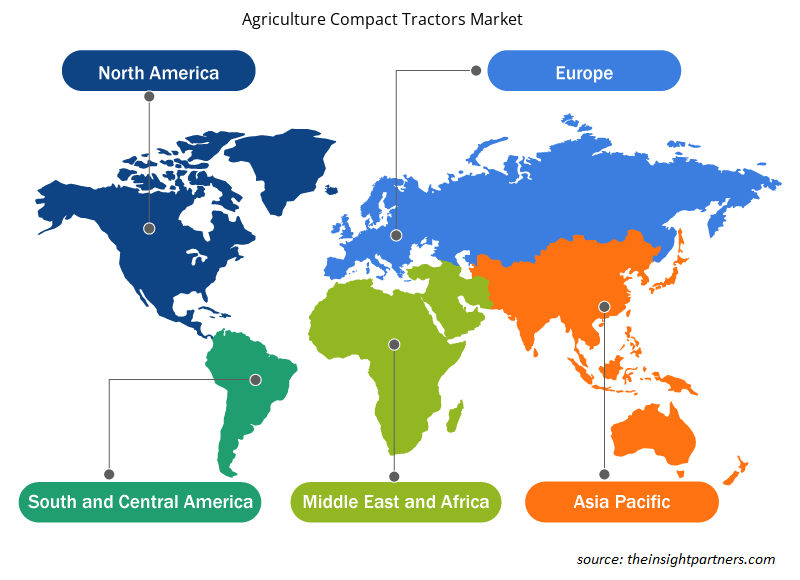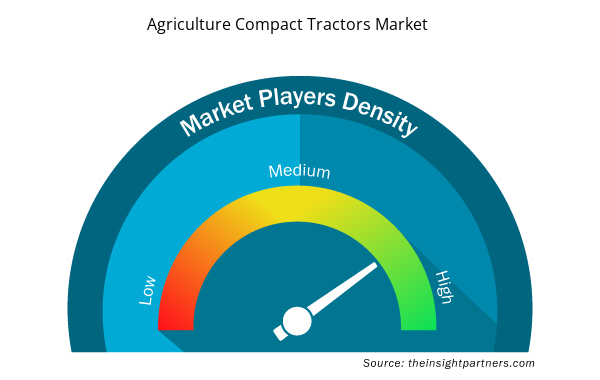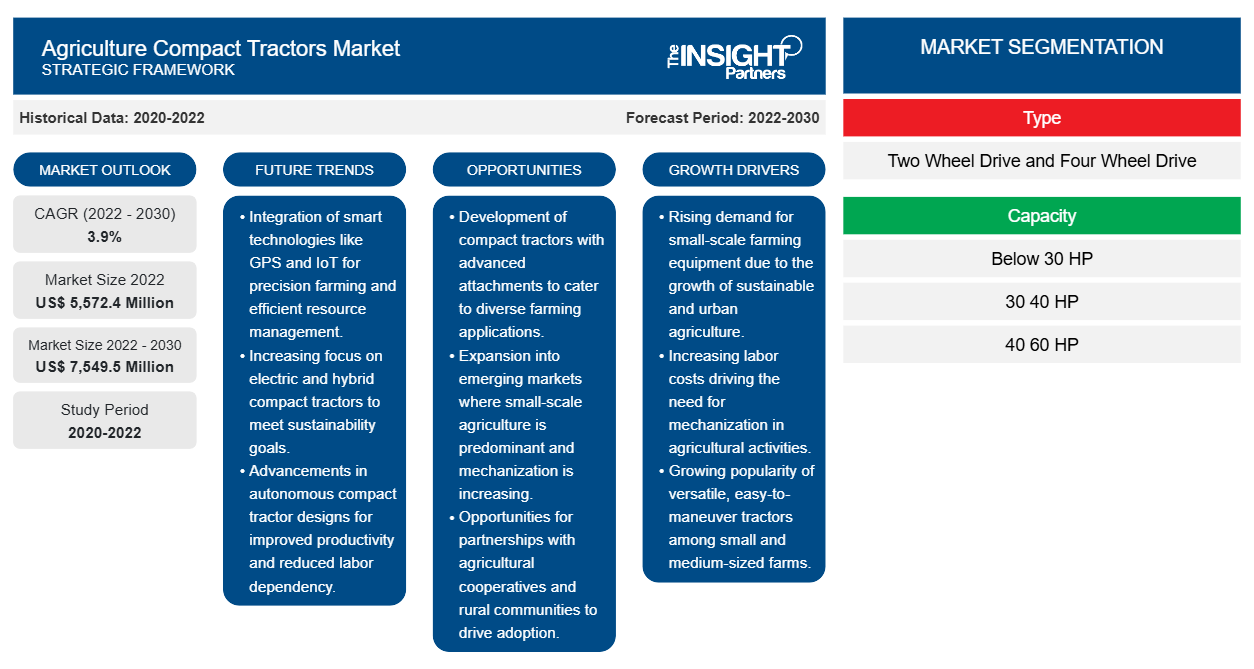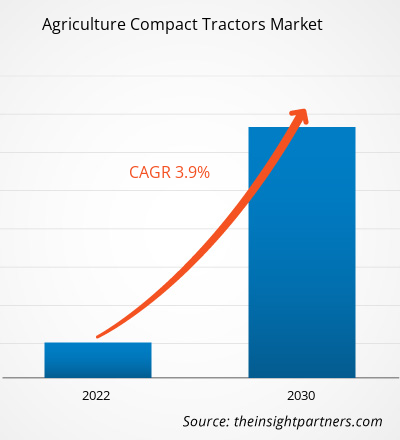[研究报告] 农业小型拖拉机市场规模预计将从 2022 年的 55.724 亿美元增长到 2030 年的 75.495 亿美元;预计 2022 年至 2030 年市场复合年增长率为 3.9%。
分析师观点:
农业部门的不断发展以及对现代设备的日益青睐推动了全球小型农业拖拉机市场的增长。随着人口的不断增长,对粮食的需求也在增加。根据联合国最近的预测,世界人口预计将在 2030 年达到 85 亿,到 2050 年将进一步扩大到 97 亿。因此,对农产品的需求正在迅速增加,这给农民带来了提高农场产量的负担。因此,农业活动规模的扩大推动了对小型农业拖拉机的需求。
2024 年 1 月,韩国重型机械和电子元件制造商 LS Mtron Co. 在北美推出了新型 MT2·MT2E 小型拖拉机系列。该系列的两款型号——高端 MT2 和经济型 MT2E——旨在提高受限空间内的操作便利性,适合小规模农业。该产品系列专为各种作业而设计,包括易于使用的梭子,可实现平稳的前进和后退操作,以及适合转移土壤或碎石的双踏板。农业紧凑型拖拉机制造商的此类产品开发活动推动了农业紧凑型拖拉机市场的增长。
市场概况:
小型拖拉机通常称为小型多用途拖拉机,主要用于小型农场活动,如犁地、割草、播种、耕作和拖运。它们体积小,容量大,更适合小型农场、果园和坚果园、葡萄园、花园和草坪。小型拖拉机耗油少,维护要求低,因此运营成本低。
由于中国和印度等国家农业活动规模庞大,亚太地区在农业紧凑型拖拉机市场占据主导地位。然而,预计北美和欧洲在预测期内将实现强劲的复合年增长率。美国是坚果和水果的主要生产国之一。根据美国农业部 2022 年发布的数据,小型家庭农场占美国农场总数的 88%。因此,美国拥有大量小型农场是该国农业紧凑型拖拉机市场受益的关键因素。
定制此报告以满足您的需求
您可以免费定制任何报告,包括本报告的部分内容、国家级分析、Excel 数据包,以及为初创企业和大学提供优惠和折扣
- 获取此报告的关键市场趋势。这个免费样品将包括数据分析,从市场趋势到估计和预测。
市场驱动因素:
政府支持小规模农户的举措
政府政策和资金等支持性举措推动了不同国家小型农场的数量。例如,美国农业部向小规模和初级农民提供小额贷款计划,使他们能够通过简单的申请获得高达 35,000 美元的贷款。此外,2023 年,圭亚那政府通过其国家粮食系统途径计划宣布了一项倡议。作为该项目的一部分,向全国各地的小农户和持续社会经济赋权计划的参与者提供了农业投入品和一次性现金补助。这些政府举措正在使小规模农民能够采用包括小型拖拉机在内的农业设备。此外,这些计划和举措为发展中国家和发达国家的小型农业农场创造了有利的环境,最终导致农业小型拖拉机市场规模的扩大。
节段分析:
农业紧凑型拖拉机市场分析考虑了以下几个部分:类型、容量和应用。根据容量,市场细分为 30HP 以下、30HP-40HP 和 40HP-60HP。40HP-60HP 和 30HP-40HP 部分合计占农业紧凑型拖拉机市场份额的 50% 以上。这些拖拉机适用于中型农场,用于犁地、耕作、种植和收割等任务。例如,Farmtrac 于 2024 年推出了其新款 Farmtrac 60 Powermaxx 拖拉机。这款拖拉机配备 55 马力发动机,并提供多种功能。
区域分析:
农业紧凑型拖拉机市场报告的地理范围包括北美(美国、加拿大和墨西哥)、欧洲(西班牙、英国、德国、法国、意大利和欧洲其他地区)、亚太地区(韩国、中国、印度、日本、澳大利亚和亚太其他地区)、中东和非洲(南非、沙特阿拉伯、阿联酋和中东和非洲其他地区)以及南美洲和中美洲(巴西、阿根廷和南美洲和中美洲其他地区)。2022 年,亚太地区占据了农业紧凑型拖拉机最大的市场份额。
北美农业紧凑型拖拉机市场分为美国、加拿大和墨西哥。北美的农业部门,特别是美国、加拿大和墨西哥等国家的农业部门,主要推动了对农业紧凑型拖拉机的需求。农业部门的扩张和持续的产品开发将在未来继续推动该地区的市场发展。根据美国农业部 2021 年发布的数据,农业部门在 2021 年为美国 GDP 贡献了约 1.264 万亿美元,占全国 GDP 的 5.4%。根据加拿大政府 2022 年发布的数据,农业和农业食品部门对加拿大经济做出了重大贡献。加拿大农产品销售额以年增长率 5.6% 的速度增长,2022 年总额达到 877 亿美元。小型农场数量的增加导致对紧凑型拖拉机的需求增加,这为供应商提供了新的增长途径。此外,美国许多主要参与者目前正致力于开发全自动紧凑型拖拉机,预计此类发展将在未来几年为北美带来新的农业紧凑型拖拉机市场趋势。
农业小型拖拉机市场区域洞察
Insight Partners 的分析师已详细解释了预测期内影响农业小型拖拉机市场的区域趋势和因素。本节还讨论了北美、欧洲、亚太地区、中东和非洲以及南美和中美洲的农业小型拖拉机市场细分和地理位置。

- 获取农业小型拖拉机市场的区域特定数据
农业小型拖拉机市场报告范围
| 报告属性 | 细节 |
|---|---|
| 2022 年市场规模 | 55.724 亿美元 |
| 2030 年市场规模 | 75.495 亿美元 |
| 全球复合年增长率(2022 - 2030 年) | 3.9% |
| 史料 | 2020-2022 |
| 预测期 | 2022-2030 |
| 涵盖的领域 | 按类型
|
| 覆盖地区和国家 | 北美
|
| 市场领导者和主要公司简介 |
|
农业小型拖拉机市场参与者密度:了解其对业务动态的影响
小型农业拖拉机市场正在快速增长,这得益于终端用户需求的不断增长,而这些需求又源于消费者偏好的不断变化、技术进步以及对产品优势的认识不断提高等因素。随着需求的增加,企业正在扩大其产品范围,进行创新以满足消费者的需求,并利用新兴趋势,从而进一步推动市场增长。
市场参与者密度是指在特定市场或行业内运营的企业或公司的分布情况。它表明在给定市场空间中,相对于其规模或总市场价值,有多少竞争对手(市场参与者)存在。
在农业小型拖拉机市场运营的主要公司有:
- 洋马拖拉机
- 马恒达
- 泰懋股份有限公司
- 索莱克
- 约翰迪尔
免责声明:上面列出的公司没有按照任何特定顺序排列。

- 获取农业小型拖拉机市场顶级关键参与者概览
关键球员分析:
AGCO GmbH、Yamaha Tractors、Solis、Bobcat Company、Mahindra Tractors、Kubota、John Deere、Massey Ferguson 和 New Holland 是农业紧凑型拖拉机市场报告中介绍的知名企业。除了这些企业之外,本研究还研究和分析了其他几家重要公司,以全面了解全球多功能紧凑型拖拉机市场。
最新动态:
全球小型农业拖拉机市场中的公司普遍采用并购等无机和有机战略。根据新闻稿,以下列出了主要小型农业拖拉机市场参与者的一些最新发展:
年 | 消息 | 地区 |
2023 年 8 月 | Case IH 推出了新款 Farmall Subcompact 25SC 拖拉机。这款新推出的车型是 Case IH 产品组合中最小的拖拉机。这款新拖拉机的发动机功率范围从 25 马力到 115 马力。 | 亚太地区 |
2023 年 2 月 | 山猫推出了一系列新型紧凑型拖拉机,名为 1000、2000 和 4000 系列。该系列有九种紧凑型拖拉机型号,根据发动机功率进行区分。这些拖拉机的功率范围在 25 至 85 马力之间。 | 欧洲 |
- 历史分析(2 年)、基准年、预测(7 年)及复合年增长率
- PEST 和 SWOT 分析
- 市场规模价值/数量 - 全球、区域、国家
- 行业和竞争格局
- Excel 数据集



Report Coverage
Revenue forecast, Company Analysis, Industry landscape, Growth factors, and Trends

Segment Covered
This text is related
to segments covered.

Regional Scope
North America, Europe, Asia Pacific, Middle East & Africa, South & Central America

Country Scope
This text is related
to country scope.
常见问题
Continuous adoption of electric vehicles owing to increased focus on sustainability is one of the trends that is expected to drive the demand of the electric agriculture compact tractors market.
AGCO GmbH, Yamaha Tractors, Solis, Bobcat Company, Mahindra Tractors, Kubota, John Deere, Massey Ferguson, and New Holland are the key market players operating in the global agriculture compact tractors market.
Regions such as Europe, North America and Asia-Pacific will boost the growth of the agriculture compact tractors market during the forecast period. This growth is owing to the rise in investment for the adoption of the modern agriculture equipment and vineyards in the regions.
Many compact tractor manufacturers are focusing on developing fully automated compact tractors. Such development is projected to generate lucrative opportunities for the agriculture compact tractors market during the forecast period.
High customization options and low cost of compact tractors are a few of the factors contributing to the expansion of the agriculture compact tractors market size. Farming requires a wide range of agricultural equipment, and tractors form an unintegral part of this set of equipment. Purchasing various farm equipment can be expensive, whereas low prices of a small tractor provide some relief to agriculturists and farm owners. Lower price is especially a primary factor driving the adoption of agriculture compact tractors in in agriculture-dominating economies such as China and India, which are home to numerous small and low-margin farmers.
Trends and growth analysis reports related to Manufacturing and Construction : READ MORE..
The List of Companies - Agriculture Compact Tractors Market
- YANMAR Tractor
- Mahindra
- TYM CORPORATION
- Solectrac
- John Deere
- AGCO GmbH
- Bobcat Company
- New Hollland
- Massey Ferguson
- TAFE
- Jinma Tractor
- LANSU
The Insight Partners performs research in 4 major stages: Data Collection & Secondary Research, Primary Research, Data Analysis and Data Triangulation & Final Review.
- Data Collection and Secondary Research:
As a market research and consulting firm operating from a decade, we have published and advised several client across the globe. First step for any study will start with an assessment of currently available data and insights from existing reports. Further, historical and current market information is collected from Investor Presentations, Annual Reports, SEC Filings, etc., and other information related to company’s performance and market positioning are gathered from Paid Databases (Factiva, Hoovers, and Reuters) and various other publications available in public domain.
Several associations trade associates, technical forums, institutes, societies and organization are accessed to gain technical as well as market related insights through their publications such as research papers, blogs and press releases related to the studies are referred to get cues about the market. Further, white papers, journals, magazines, and other news articles published in last 3 years are scrutinized and analyzed to understand the current market trends.
- Primary Research:
The primarily interview analysis comprise of data obtained from industry participants interview and answers to survey questions gathered by in-house primary team.
For primary research, interviews are conducted with industry experts/CEOs/Marketing Managers/VPs/Subject Matter Experts from both demand and supply side to get a 360-degree view of the market. The primary team conducts several interviews based on the complexity of the markets to understand the various market trends and dynamics which makes research more credible and precise.
A typical research interview fulfils the following functions:
- Provides first-hand information on the market size, market trends, growth trends, competitive landscape, and outlook
- Validates and strengthens in-house secondary research findings
- Develops the analysis team’s expertise and market understanding
Primary research involves email interactions and telephone interviews for each market, category, segment, and sub-segment across geographies. The participants who typically take part in such a process include, but are not limited to:
- Industry participants: VPs, business development managers, market intelligence managers and national sales managers
- Outside experts: Valuation experts, research analysts and key opinion leaders specializing in the electronics and semiconductor industry.
Below is the breakup of our primary respondents by company, designation, and region:

Once we receive the confirmation from primary research sources or primary respondents, we finalize the base year market estimation and forecast the data as per the macroeconomic and microeconomic factors assessed during data collection.
- Data Analysis:
Once data is validated through both secondary as well as primary respondents, we finalize the market estimations by hypothesis formulation and factor analysis at regional and country level.
- Macro-Economic Factor Analysis:
We analyse macroeconomic indicators such the gross domestic product (GDP), increase in the demand for goods and services across industries, technological advancement, regional economic growth, governmental policies, the influence of COVID-19, PEST analysis, and other aspects. This analysis aids in setting benchmarks for various nations/regions and approximating market splits. Additionally, the general trend of the aforementioned components aid in determining the market's development possibilities.
- Country Level Data:
Various factors that are especially aligned to the country are taken into account to determine the market size for a certain area and country, including the presence of vendors, such as headquarters and offices, the country's GDP, demand patterns, and industry growth. To comprehend the market dynamics for the nation, a number of growth variables, inhibitors, application areas, and current market trends are researched. The aforementioned elements aid in determining the country's overall market's growth potential.
- Company Profile:
The “Table of Contents” is formulated by listing and analyzing more than 25 - 30 companies operating in the market ecosystem across geographies. However, we profile only 10 companies as a standard practice in our syndicate reports. These 10 companies comprise leading, emerging, and regional players. Nonetheless, our analysis is not restricted to the 10 listed companies, we also analyze other companies present in the market to develop a holistic view and understand the prevailing trends. The “Company Profiles” section in the report covers key facts, business description, products & services, financial information, SWOT analysis, and key developments. The financial information presented is extracted from the annual reports and official documents of the publicly listed companies. Upon collecting the information for the sections of respective companies, we verify them via various primary sources and then compile the data in respective company profiles. The company level information helps us in deriving the base number as well as in forecasting the market size.
- Developing Base Number:
Aggregation of sales statistics (2020-2022) and macro-economic factor, and other secondary and primary research insights are utilized to arrive at base number and related market shares for 2022. The data gaps are identified in this step and relevant market data is analyzed, collected from paid primary interviews or databases. On finalizing the base year market size, forecasts are developed on the basis of macro-economic, industry and market growth factors and company level analysis.
- Data Triangulation and Final Review:
The market findings and base year market size calculations are validated from supply as well as demand side. Demand side validations are based on macro-economic factor analysis and benchmarks for respective regions and countries. In case of supply side validations, revenues of major companies are estimated (in case not available) based on industry benchmark, approximate number of employees, product portfolio, and primary interviews revenues are gathered. Further revenue from target product/service segment is assessed to avoid overshooting of market statistics. In case of heavy deviations between supply and demand side values, all thes steps are repeated to achieve synchronization.
We follow an iterative model, wherein we share our research findings with Subject Matter Experts (SME’s) and Key Opinion Leaders (KOLs) until consensus view of the market is not formulated – this model negates any drastic deviation in the opinions of experts. Only validated and universally acceptable research findings are quoted in our reports.
We have important check points that we use to validate our research findings – which we call – data triangulation, where we validate the information, we generate from secondary sources with primary interviews and then we re-validate with our internal data bases and Subject matter experts. This comprehensive model enables us to deliver high quality, reliable data in shortest possible time.


 获取此报告的免费样本
获取此报告的免费样本